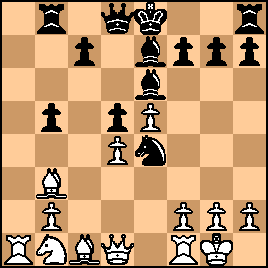| KEG: A short, workmanlike demolition of Mason by Tarrasch. Throughout his career, Tarrasch virtually owned Mason, defeating him six times and drawing twice in their nine meetings. The one time Mason beat Tarrasch (in the opening round at Hastings 1895) was because Tarrasch overstepped the time control because he wrote his name in line 1 of his score-sheet and therefore mistakenly believed he had made 30 move rather than the 29 he had actually made. This game was Tarrasch's first game against Mason after that catastrophe at Hastings 1895, and he was not slow to get revenge. But while Tarrasch was on top for most of this game, even here his rustiness (this was his first tournament since his victory at Vienna 1898) showed as Tarrasch on several occasions failed to find the must crushing line. Considering this game only lasted 24 moves, Tarrasch's errors here were not costly (unlike some of his other games here at Monte Carlo 1902). 1. e4 e5
2. Nf3 Nc6
3. Bb5 a6
4. Bb5 Nf6
5. 0-0 Nxe4
Playing the Open ("Tarrasch") Variation of the Ruy Lopez against Tarrasch himself! 6. d4 b5
7. Bb3 d5
8. a4?!
8. dxe5 is most usual and almost certainly best. Tarrasch's move was nonetheless a success here, since it obviously surprised Mason, who fumbled the ensuing play. The position after 8. a4 was:

click for larger view8... Rb8
Gunsberg in the Tournament Book said that this or 8...b4 were best. In reality, the simple 8...Nxd4 was better. 9. axb5 axb5
10. dxe5 Be6
11. c3
As Gunsberg noted, c3 is often a strong move for White in the Ruy Lopez. 11... Be7
12. Nd4

click for larger viewTarrasch had clearly emerged from the opening with the better position, but Black's position is not all that bad...yet. But beginning here, and for the balance of the game. Mason collapsed. 12... NxN?
A bad positional mistake, allowing Tarrasch to consolidate his center. Black would not be all that bad after 12...Qd7. In some variations, Black then has exciting counter-chances; e.g., 13. Re1 Bh4 14. NxB Bxf2+ 15. Kf1 fxN 16. RxN! 0-0 17. Rf4 Bb6 after which Black end up with two pawns and attacking prospects for the sacrificed piece. 13. cxN

click for larger view13... f5?!

click for larger viewA wild and potentially losing move for Black. Gunsberg, while recognizing the obvious major weaknesses not created in the Black army, partially justified the move, stating that "...Black must play something for the retreat of the Knight (since f3 by White seems to be coming). But the text was not the way to save the Knight. Mason should have played either 13...h5 (so the Knight can flee to g5 (e.g., 14. f3 Ng5 15. f4 Bg4 16. Qd3 c5 17. fxN c4) or 13...Bc8. None of these lines are things of beauty for Black, but the text was worse...except that Tarrasch missed his best chance here as I wll discuss in my next post on this game. | 




